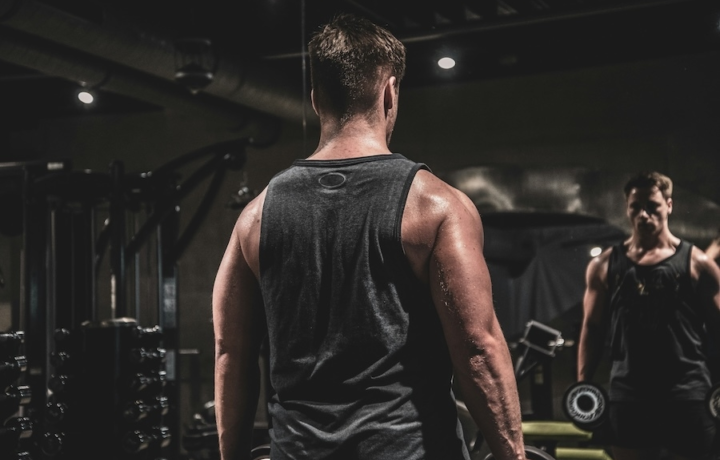Exercise
Lever Seated Shoulder Press

Lever Seated Shoulder Press
How to Perform
- Sit on the machine with your back against the pad, feet flat on the floor, and maintain a neutral spine position.
- Grasp the handles with an overhand grip, positioning your hands at shoulder width or slightly wider with wrists straight.
- Start with the handles at shoulder height, elbows bent and pointing down, and shoulders pulled back and down away from your ears.
- Brace your core muscles to stabilize your torso, ensuring your lower back maintains contact with the backrest throughout the movement.
- Exhale as you press the handles upward in a controlled motion until your arms are fully extended overhead but without locking your elbows.
- Keep your head in a neutral position, looking straight ahead, while avoiding the tendency to push your chin forward during the press.
- Inhale as you slowly lower the handles back to the starting position, controlling the descent and keeping tension in your shoulder muscles.
- Pause briefly at the bottom position before initiating the next repetition, maintaining proper posture throughout the set.
Important information
- Make sure your lower back stays in contact with the backrest to protect your spine – avoid arching or pushing your torso forward during the press.
- Keep your shoulders down and away from your ears throughout the entire movement to properly engage the deltoid muscles.
- Adjust the seat height so that the handles align with your shoulders in the starting position for optimal leverage.
- If you experience any shoulder pain, reduce the weight or modify your hand position to find a more comfortable range of motion.

Lever Seated Shoulder Press
Exercise Details
Primary Muscles
Muscle Groups
Mechanic
Risk Areas
Built for progress
Take the guesswork out of training
Create personalized AI-powered workout plans that evolve with you. Train smarter, track every rep and keep moving forward, one workout at a time.






The Lever Seated Shoulder Press stands as a cornerstone movement in any serious shoulder development routine, offering a perfect blend of stability and focused tension for intermediate lifters looking to build impressive deltoid mass. This machine-based press primarily targets the anterior (front) and lateral (side) deltoid heads while engaging the triceps as secondary movers throughout the pressing motion.
Unlike free weight variations, the lever mechanism provides a fixed path of motion that allows lifters to concentrate purely on output rather than stabilization, making it particularly valuable for bodybuilding purposes. The guided movement pattern reduces the learning curve typically associated with overhead pressing while still delivering substantial muscle activation across the shoulder complex.
For strength enthusiasts, the Lever Seated Shoulder Press offers remarkable benefits through its capacity for progressive overload. The weight stack or plate-loading design typically permits incremental resistance adjustments, allowing for precise tracking of strength gains over time. This methodical approach to increasing load serves as an excellent stimulus for both myofibrillar and sarcoplasmic hypertrophy when programmed appropriately.
Many bodybuilders appreciate this exercise for its ability to create significant metabolic stress and mechanical tension in the deltoids without the systemic fatigue that often accompanies barbell variations. The seated position provides crucial back support, reducing the risk of compensatory movement patterns that might otherwise diminish shoulder engagement.
When incorporated into a well-designed upper body routine, this movement can serve as either a primary compound exercise or as a secondary movement following more technically demanding presses. Its versatility makes it suitable for various rep ranges – from heavy sets of 6-8 repetitions for strength emphasis to moderate sets of 10-15 repetitions for hypertrophy-focused training.
For those seeking symmetrical shoulder development, the unilateral versions of this machine can help address muscular imbalances while maintaining the safety benefits inherent to the lever design. This attention to proportional development represents the thoughtful approach that intermediate lifters must adopt as they progress toward advanced training methodologies.
FAQ - Lever Seated Shoulder Press
The Lever Seated Shoulder Press primarily targets the anterior (front) and lateral (side) deltoid heads while engaging the triceps as secondary movers. The fixed path of motion allows for concentrated tension on these muscle groups without requiring significant stabilizer involvement.
The machine version provides a fixed movement path that reduces the need for stabilization, allowing you to focus purely on output and deltoid engagement. This makes it particularly valuable for bodybuilding purposes and can be safer for those with minor shoulder issues since it controls the movement pattern.
Include this exercise 1-2 times weekly with at least 48 hours between sessions to allow for adequate deltoid recovery. It works well as either a primary compound movement or as a secondary exercise following more technically demanding presses in your shoulder or push day routine.
Avoid arching your lower back or lifting your buttocks off the seat when pressing heavier weights. Keep your core braced, maintain contact with the backrest throughout the movement, and don't lock out your elbows at the top position to maintain tension on the deltoids.
Yes, many machines offer unilateral (single-arm) options that allow you to address strength discrepancies between sides. Alternatively, you can perform the standard version but focus on equal force production from both shoulders, ensuring the machine moves evenly without tilting to one side.







